There are tons of different methods of learning, just as there are tons of different types of schools. So how do you know which one is the right one for your class? This is sort of a trick question because no teacher uses only one method. And many teachers use methods that they have developed themselves over years of experience.
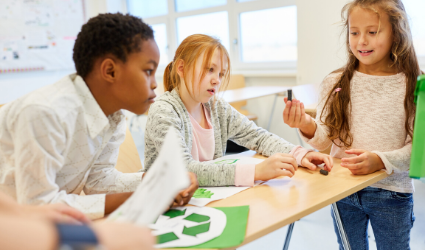
So then, what is universal design for learning and how can it benefit your students? Universal Design for Learning (UDL) is a program of learning that identifies and breaks away barriers to your students’ learning abilities. It then goes a step further to maximize learning for each of your students individually. All in the course of a school day!
So how can this be possible, especially when many classes have upwards of 25 or more students, all with very different personalities, passions, and learning skills?
Actually, I bet you are already doing some of them in your classroom, just based on the fact that as you get to know your students and relate to them person to person, you are already thinking about how to deliver your message and goals to them. Let’s go a little deeper, though.
Table of Contents
The Definition of Universal Design for Learning
Since I already offered a basic definition above, I will now break down what each part of Universal Design for Learning means for your classroom.
The term “universal” refers to the fact that it is designed to capitalize on the learning strengths of everyone in every class you ever teach. That is a pretty tall order, but it really does deliver!
The term “learning” refers to three different ways that our brain processes information. They are as follows:
- Recognition–the information our brain takes in
- Skills and Strategies–how our brain functions to absorb that material
- Caring and Prioritizing–why we learn
The term “design” refers to how we can accommodate one facility or process to benefit as many different kinds of users as will want or need to access the facility or process. In buildings, we would be talking about handicap access. It is not needed by everyone, but people are not hindered by its presence and many handicapped people would not be able to go there without it. So it benefits the most people at one time.
Why UDL Works so Well
The strength of this program is that it doesn’t matter what type of student you are. You can be genius, average, disabled, privileged background, difficult background, foreign background. All students are able to thrive based on taking advantage of their own strengths to learn the material and concepts in their best way.
This does not mean they are “taking the easy way out” or not actually earning their grades. If you find a better and more efficient way to do a job at work, does that mean you are cheating the system, not doing your job enough, or shirking your responsibilities?
Adding this concept to education allows you to form a program that helps students to absorb and retain lessons better with processes that benefit the whole class simultaneously.
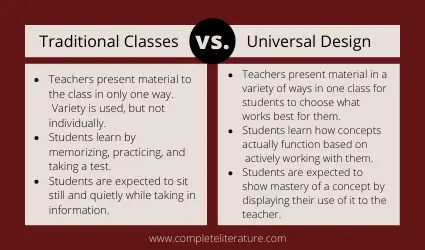
History and Source of Universal Design for Learning
Additionally, Universal Design for Learning was developed by Anne Meyer and David Rose in the 1990’s. They used scientific methods and principles to learn how people’s brains actually work. And then they used that information to work out the best and most efficient ways to teach students in any classroom atmosphere.
This process allowed Meyer and Rose to develop a program that worked with students instead of trying to force them to figure things out in more traditional and less functional ways.
Examples of Universal Design for Learning in our World
We actually all see various examples of Universal Design for Learning everywhere around us. But because it is such a normal part of life, we generally don’t give any of them a second thought.
Basically, universal design around us looks like the measures made in our society that allow life to be easier for everybody.
I came up with some great examples of this. As you read them, think about what other examples you see on a daily basis!
Braille Letters on Door Signs and Other Random Places in Public
We barely even notice this because most of us are not blind. But for blind people, these norms in our society are absolutely necessary to function in public spaces.
We generally find them near restroom doors, on ATM keypads, some landline phone keypads, as well as on some television or electronic product boxes.
Also, in major cities, especially if they have a school for the blind, you can find street names in Braille on poles at larger intersections.
In hospitals, you can find them near or on doors, on the tv remotes, and on the bed controls.
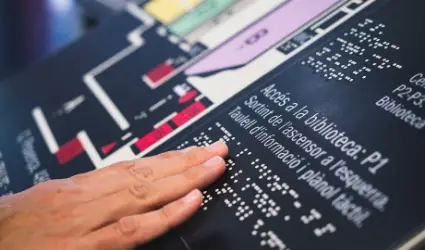
White is Right
This is one more benefit that blind people enjoy because realistically we cannot put braille everywhere around us.
So what exactly is “white is right?” When you go to a restaurant and look at the containers with sugar packets, you will often find that the white packets of sugar are on the right hand side. That is for blind people to know and select their preferred sugar packets.
I have to say, I had no idea this was a thing until I worked as a server in a restaurant and one of my side jobs was keeping tables clean and supplied. I bet this is something that nobody has any idea about unless they are blind, have a friend who is blind, or work in a restaurant that honors this policy.
Emergency Situations in Public
I am writing this article in the middle (or actually hopefully closer to the end) of quarantine measures for Coronavirus. And there have been so many things done to help us all adjust to these drastically different days. There are, of course, signs on most doors to every public building. And you will notice markings on most floors of stores allowing you to know exactly how far apart you should stand to maintain healthy distances.
Altered Sidewalks
You will notice that most sidewalks no longer end abruptly, but rather have mini-ramping at the end. That is to make life easier for people in wheelchairs, people with baby strollers, or even people with carts in a store parking lot.
There are myriad examples like this that we can see everywhere we go. And we don’t even realize how much easier life is with them because they are done automatically for us.
The Three Principles of Universal Design for Learning
Engagement
Engagement refers to how the teacher will get 100% of their students to be fully engaged and productively learning in the classroom.
When it is the beginning of the year and teachers are getting to know their students, it is harder to know exactly how to do this part of the process. But it really doesn’t take much time to figure it out.
Kids are always eager to share what their favorite things are with their teachers. So taking a few minutes with each child to interact and learn those things will give the teacher myriad options within the first few days of school starting.
And fortunately for teachers, because it really is true that there is nothing new under the sun, they will most likely already have tons of resources in place that will allow them to set these things up with their students.
Once you have learning options available that your students can immerse themselves into, you will see their interest in classroom activity increase exponentially.
Having multiple options available (make sure the prep is light on these so that you are not sacrificing extra time that you don’t have) will allow the students to further immerse themselves in what they enjoy.

Representation
Representation speaks to teachers presenting the learning materials in a variety of formats that allow students to learn at their own pace and ability. Or it could even be at their own preference.
It really doesn’t matter what method they are using if they are productively learning. Or maybe I should say it matters that they choose the best method that works for them.
This could be the textbook for those that prefer to read. But it could also be video, interviews with people, audio, games that include facts they need to learn, projects that they must figure out the solution to the problem presented, or virtually any way that you can transfer information.
Action and Expression
In this third principle, the idea is for the students to be able to demonstrate their knowledge and abilities in ways that are a strength to them and not a downfall.
I have a daughter that was an A/B student throughout her school years. that only had B’s because she was terrible at test-taking. She could show mastery of all of the material in class discussion, written essays, and any type of project you gave her to do.
But when she had to take a written test, she would score poorly or even fail it MOST OF THE TIME! It usually left her in tears and so frustrated because she was so sure she knew the material well. And she would even think she had done well on the test–until the results came back.
By the time she got to college, the professors did a pretty good job recognizing that and worked around it with her very well. And she graduated with good grades and a Bachelors Degree. Plus the satisfaction that she would likely never take a written test again!
That is the point of this whole principle. It is so much more important to find the best way for individual students to demonstrate mastery than to pass a written test that doesn’t necessarily pull out all the information that a person has learned.
That being said, I realize that you can’t just announce to your administration that you will no longer be testing those students that have a hard time with testing regardless of their mastery of the material. But what you can do is work specifically with those students to help them test better or find projects for extra credit that can help them elevate those test grades to a more accurate representation of the level of their mastery.
How to Apply Universal Design for Learning to Four of the Components of Curriculum
I do want to note here that several curricula are split into more than four components. I have an article that goes more into depth about that if you want to click here.
That being said, there is not a set number of components of a lesson plan method. As long as they are clear in the components they want to focus on, it’s all good.
Goals
In the realm of goals, there are two points that are extremely important: communicating them accurately to your students in a way they can easily understand and communicating them in a way that motivates and excites your students to then learn the material that achieves the goals.
When you are using the strengths of your students to accomplish academic, socio-emotional or other goals, you have already won this battle. Your students will come to school excited about what you may have planned for their day or week. And I don’t need to tell you how important that is for moving on to the important work of the class.
If you aren’t trying to drag your students along with you, your day/week/quarter/semester/year will go so much more smoothly and efficiently. Imagine a classroom where everyone is working with each other instead of against each other. And everyone is actually having fun.
Of course, reality dictates that every day will not be the best day ever. And sometimes you just have to get down and do the hard work. But when the program is geared toward everybody’s strengths, life is automatically better.
Instructional Materials
These are the materials that you are going to use to guarantee the strength of all of your students will be met. As a side benefit, you will find that you as a teacher will rarely be bored when there is plenty of variety in your classroom!
Some examples of materials will be books (text or more entertainment based), videos, podcasts, themed art examples, or literally anything in the world that you can think of that you can reasonably either get into the classroom or take the kids to.
Instructional Methods
The instructional methods will be the most important part of all of the components. It is the activity that the students use to actually learn and confirm the material in their minds.
One of the biggest hallmarks of a universal design classroom is that there is flexibility in where the students spend their time at each class. If they want to be in a quiet corner, or closer to the board, or with a certain group of students, the idea is that they can move around as it benefits them.
You will need to make sure that there are rules in place that keep this from being a distraction in your classroom. I found that it was motivation enough for my students that they knew as long as they were not distracting, they would have all the freedom they needed to move around. The minute things got chaotic they would lose their privileges. Because they knew that, chaos was a rare occurrence. They enjoyed their freedom.
Letting the students move around the room to work as benefits them will give them a sense of freedom and responsibility that make their “job” at school seem more important and worth doing. And what excellent ways to prepare them for their job in the workplace!
Make sure you are available to give them productive feedback and answer any questions they have. And make sure that you aren’t blowing the wind out of their sails with your advice or answers! It may not be the project that you would have wanted to do, but if it is helping them to learn the concepts well, then your goals are being accomplished.
Working in Groups
This may be the best way for students to learn when all of them are engaged. It is the perfect opportunity for students that already know a significant amount about the subject to share what they know with others.
And it allows the students that have had little to no exposure to the subject to be able to experience the facts, rather than be spoon fed them by a lecture that their mind can’t stay focused on.
Adding physical learning methods to the group learning format only serves to further reinforce what your students are learning.
Assessment
I have already spoken about testing in the section above on action and expression.
This principle is the same as all other curriculum methods. But the difference is that you are letting your students use their strengths and abilities to prove mastery rather than answering flat questions on a page.
And if this doesn’t resemble real life more than a written test, nothing does! They will be learning so much more than how to select the right answer to a question. They are learning how life works, how things relate to one another, and how to manipulate information to make it work for them.
And your evaluation of their mastery of information will be a lot more fun than taking home papers to grade!
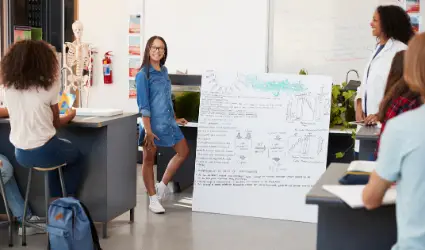
An Additional Resource
I do want to share with you something that really helped me out. And it’s free! There is a video course that was created by Iris Center, an extension of Vanderbilt University’s Peabody College. This course is available for anybody to take and consists of 5 modules that total a little over 2 hours of material. So you can watch or listen at your leisure in small bits to get even more information on how to make this work in your classroom. To take a look, click on the Iris Center page here.
One of the best things I love about the Iris Center is that their instructional advice and materials are for anybody who wants to learn them. And the icing on the cake: they are designed to work with students of virtually any background and learning ability or disability.
Conclusion
So this is Universal Design for Learning (UDL) in a nutshell. I hope that this article has given you a good taste of what this can do for you and your students (or even you and your children if you are a parent reading this).
Now that you’ve read about all of this, I found a perfect short video that will show you what it looks like in practice in the classroom:
What I loved about this video is that teacher Eric Crouch’s own difficult school experience as he was growing up allowed him to know better how to relate to students’ difficulties. He made a really good point that most teachers were excellent students in class, so they don’t always understand firsthand the difficulties that their struggling learners are facing.
I also love how he guides the students to knowledge by asking them questions that guide them through the lesson. This is so much better for the students than just spoon-feeding them the information.
If you enjoyed this article, I think you will also enjoy these other articles about various teaching/learning methods:
Helpful Examples of Differentiated Instruction
The Madeline Hunter Lesson Plan: Should We Still be Using It?
The 5e Lesson Plan: Everything You Need to Know About It
Problem-Based Learning: Boosting Your Students’ Success in the Real World

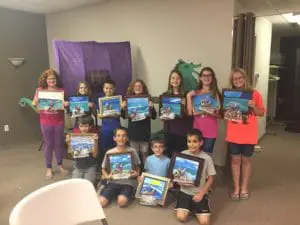


Wow! I enjoyed reading that! Though each of us will be unique and different from one another, there are also some things that are common to all of us.
It is always so interesting to learn about the studies that people have done about how we as people can learn best, no matter our differences. It’s great to know there are ways to make a space accessible to all!
Love to read an educational topic, the universal design for learning material is very much supportive for teachers, students and it is more useful for traditional teachers….
I always find it so interesting when there are studies on learning and the best was to learn. Thanks so much for sharing this with all of us!
While this is really far from the traditional method of teaching and may need more work for teachers, I believe thisnis a good strategy since not all kids have similar comprehension level.
Very interesting. I love how there is more time being invested into learning about, well, different learning styles. Rather than just lumping us all into one group and one style of learning.
I love learning about all of it too, Nyxie! Thanks for sharing your thoughts. 🙂
Wow! UDL is really interesting. I love how Eric used and turn his difficult learning experience into something positive and useful. Thank you for sharing!
I loved that too. What a profound experience to share! Thank you for your thoughts, Cha!
I definitely prefer UDL but I work in a system that heavily leans towards traditional styles. It’s frustrating.
It is frustrating. I had a teacher in 5th grade that would sneak in bits of this style of learning whenever he could. Of course all of the kids loved his classes the most. Because they felt like he was actually paying attention to them so much more. Thank you for sharing. I hope things get better for you!
Not all students can grasp new learnings using one method. That’s why some people thinks there are dumb students, but I believe they are not dumb. They just need unconventional methods in studying the topic.
Albert Einstein’s teachers said he was dumb. Good thing he didn’t pay much attention to them, at least later on. It is so unfortunate. How many others actually did fall through the cracks that could have had the potential of Einstein because their learning model “didn’t fit in?”
Every student needs a different method to learn. If all were same, then no student would ever get less marks or excel at one subject while performing poorly in other. Thank you for enlightening me with different study styles.
We may be different individually, but there’s always something that we can all relate to. And that also applies to learning.
This is so great. I feel like I was one of those kids in school who needed extra learning tools/a different method of teaching. It’s so awesome how far we’ve come with technology to be able to do these kinds of things for kids who need it!
There are kids out there who really want to learn, but doesn’t poses the materials to do so. Having a lot of different opitions for getting learning material makes it really convenient for many students.
It does. Hopefully most of the teachers will recognize those kids before they fall through the cracks. I really think that a lot of the teachers do. You tend to bond well to kids that you are with all day every day. 🙂
I hope you got the help you needed, Shelby! You sound like a person that will go get what you need to succeed. 🙂 And for as many problems as technology can present, it also is such a life saver!
This sounds pretty awesome to me. Natalie was saying she misses working in groups. Obviously everyone is at home now so it’s more difficult to do.
That is true. Even online groups is difficult. I meet in a couple of online groups right now and it is so much harder than just meeting in person. And the numbers are lower, most likely because of that.
This is so amazing how can we apply learning in a universal language is fascinating and I think is a great method to apply in a classroom and in daily life
Action and expression is so important when learning. Kids need to be shown that they’ve strengths, even if they’ve not done so well. UDL is a very interesting subject.
Yes, Lisa! The more we can encourage the positive, the more they will try to make it work. Thank you for sharing.
This sounds like a good way to teach many different types of learners. I will have to try some of these with my boys
This is really interesting to learn. It is great that we are looking into so many alternative methods as not everyone fits into the same box for how we learn.
Sounds like a very interesting way to learn. I would love to give it a try since I struggle to find a good learning activities.
I hope it works for you!
Yet another well researched and informative article. Interesting to know about Universal Design for Learning.
This type of learning is new to me, but upon reading your post at least now I have a background on UDL already.
This is awesome that education practices are finally meeting the various needs of students. Gone are the days when everyone should conform to the norm or be left behind. I can’t wait to see how things develop in education over the next 20 years.
I agree, Alvern. I think things are changing pretty fast. And with the way the world is constantly changing, I bet we can’t even fathom what schools will be like in 20 years!
It was very interesting to read about UDL. When I was in school , traditional styles were used and I used to suffer a lot as I couldn’t understand everything but the “brainier” kids used to understand everything instantly. I am so glad that my kids are learning through modern teaching methods and are less pressured than I was.
It’s awesome to see the positive changes.
Enjoyable read. Though we are all different, we can always find commonalities.
It’s good to know new changes about education for kids. Thanks for this informative post!
Wow, UDL is very cool! It is so awesome that it caters to all student’s learning needs.
I love this because although different, we still are one!
This movie sounds really interesting. I’ll check it out!
Great post! It is very helpful for me as I enrolled on several courses now to fill in extra time I have and grow a little
This was a really informative read. I always loved to work in groups.
Every students have different ways of learning but I’m glad there’s a universal design for learning that takes advantage of the different strength of students.
I have friends who are teachers. They definitely have struggled with trying to find a good way to keep the students engaged. It can be so challenging during this crazy time.
That is very true. This is a challenging time. I’m sure teachers are so ready to get back to normal school life.
How much better would our education system be if teachers had more resources available to help students learn based on individual needs than to put everyone in the same learning box? Our educational system has come far but still has far to go.
You are exactly right, Jocelyn. As far as education has come, it has a ways to go. I am hopeful though!
I love how UDL allow each student use their own strengths to learn the material and concepts. Nice read
I recently understood how important ramps and accessible paths for people with disabilities are. I broke my ankle and I had to be in a wheelchair for 3 weeks and well the world changed for me. If you are a teacher it is really important to understand how each one of your students is unique and that no everything works the same for all of them. Just like the ramps, No everybody needs them, but they are very important for those who do need them.
Wow! I’ve really grown on virtual learning programs with this pandemic. This has been an underrated blessing, selfish of me to not think of those with disabilities.
I’ve never heard of Universal Design for Learning before. It’s fascinating to learn about though!
I personally think basic design is something each person should have in mind as well
Truly, there are reallly different types of learning and different types of people how they adapt to the learning process. I so love your perspective and learning and this is so helpful in todays time while students are stacked at home.
Thank you! I hope this is helpful to parents as well as teachers!
I am always interested in any technique that can help students from different backgrounds and educational abilities learn in the same environment.
I am always astonish about the good strategies you share here on your website. I am sure you are an amazing teacher.
Thank you!
It’s intresting! Now i know that there are diff style how kids can learn new things in a modern way.
Very interesting read, universal design for learning. I like leveraging learning techniques for my son, especially when I am homeschooling him now. Great suggestions, will utilize.
This is a really fascinating way to do things. As a homeschool mom I’ve always wondered how a teacher can teach over 20 kids, but this makes sense!
I had some extra-curricular literature classes that were as many as 26 students. Those were crazy times! And then I homeschooled up to 6 of my kids at a time. I learned that if I didn’t figure out how to work with each one efficiently we weren’t going to survive it. And now I have 4 college grads so far! Thanks for sharing, Jessie! And anytime you want to talk shop about working with your kids, send me a message!
i had never heard that about white is right either. that’s fascinating!! w/ sugar alternative packets being blue and pink i wonder what the new saying should be.
This is such a wonderful tool for learning. I’m all for anything that will advance education.
I agree with you it is a great resource. I like that the article says “Representation speaks to teachers presenting the learning materials in a variety of formats that allow students to learn at their own pace and ability. Or it could even be at their own preference”
Thank you, Elle!
I think there’s no Universal Design for Learning! I think it takes creativity and courage to get things across.
UDL is a way of thinking about teaching and learning that helps give all students an equal opportunity to succeed. This approach offers flexibility in the ways students access material, engage with it and show what they know.
I love this! Such a great idea, as now more than ever we need to look and think about different ways to learn for sure x
This is super interesting! And great to know as we enter into a new learning year in the fall.
I think we are all wondering what new world the fall will bring. I do know that I will be homeschooling my 3 youngest, who will be in 4th, 11th, and 12th grade.
please enlighten me babe: What is the goal of universal design for learning?
The goal of universal learning is to make life easier for all in a way that makes learning easier as well.
Differntiated learnign across the board is alsways so important, I wish more teachers appreciated the importance in classroom learning.
I am definitely pro learning styles and that cater to all learning types and abilities and whatever resources can help teachers do their jobs more efficiently.
XO, MJ
https://lush-fab-glam.com
Nowadays, there’s a lot of ways to learn. It looks easier for the students to learn more in easy way.